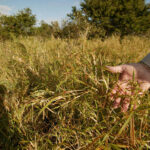The existence of the Burmese Python in the Everglades has a significant ecological effect, especially on rat populations. Burmese pythons have gradually eliminated native mammals like bobcats and foxes, while smaller mammals such as cotton rats have been left barely touched. Recently, researchers conducted a study at the University of Florida on the effect of pythons on cotton rats in regions with high and low python populations. The study revolves around the tagging and capture of 115 cotton rats. 81 were in an area with a high python population, and the remaining 34 were in an area with a low python population. The researchers tracked the rats and recorded the cause of death when any were found deceased. The results showed that while pythons killed six of the tagged cotton rats in the high python population area, overall rat death rates were similar in both areas. This suggests that pythons did not have a significant impact on the overall cotton rat population.
However, due to the devastating effect of pythons on larger mammal populations, there is now an ecosystem opening for rats to thrive. In areas where pythons are pervasive, cotton rats have become dominant. This shift in dominance can have further implications for the ecosystem. The decline of larger mammals like bobcats and foxes disrupts important ecological processes such as nutrient cycling and scavenging. Additionally, the rats themselves pose a risk to humans as they serve as reservoirs for viruses, including the Everglades virus (EVEV) and hantaviruses. Mosquitoes that feed on cotton rats can transmit these diseases to humans through mosquito bites.
Similar Post
Of particular concern is the potential spread of diseases to people living in south Florida. One species of mosquito, Culex cedecei, which tends to avoid urban areas, predominantly feeds on cotton rats. However, another species, Culex panocossa, has been found in Florida, including urban areas. In South Florida, the above-stated species is in close proximity to cotton rats, which widens the risk of arbovirus infection. One such type is the Everglades arbovirus, and its symptoms include fever, severe headaches, and muscle pain. In the rare case of the Everglades, it can cause brain swelling. The study underlines the complex ecological effects of mushrooming in the Everglades due to Burmese pythons. Pythons themselves have a direct influence over larger mammals, whereas their presence indirectly helps rat populations. This can have a negative impact on nutrient cycling, scavenging, and disease transmission. Managing the population of Burmese pythons and addressing the resulting ecological imbalances is crucial for maintaining the health and stability of the Everglades ecosystem.

















![Representative Image: European Starling [49/366]. Photo Source: Tim Sackton (CC BY-SA 2.0)](https://www.karmactive.com/wp-content/uploads/2025/04/Starlings-Drop-82-in-UK-Gardens-as-Birdwatch-2025-Reveals-Record-Low-Count-Since-1979-720x480.jpg)
